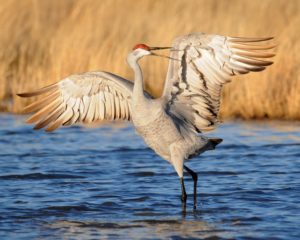For the past few months, Prairie Rivers Network has been working with the International Crane Foundation and several partners to bring the Midwest Crane Count to the Illinois River Valley. What is the count, and why is it important?

The goal of the Annual Midwest Crane Count has been to use citizen science and data collection to study the success of sandhill cranes. Healthy wetlands throughout Illinois and Wisconsin are critical for migratory populations and safe, successful nesting areas. As of now, many organized crane count efforts have been confined to the northern counties in Illinois. But we know that migratory and nesting pairs have been spotted further south.
Protecting Water Protects Wildlife
This year will be an opportunity to lay the foundation of a focused crane count in central Illinois. Our goal is to gather data at some of the most pristine, treasured areas along the Illinois River, like Dixon Waterfowl Refuge near Hennepin or Emiquon National Wildlife Refuge. George Archibald, co-founder of the International Crane Foundation, says about the effort: “It’s the start of a citizens’ science project that I hope will be repeated annually perhaps leading to rigorous scientific research to provide information upon which sound crane conservation practices can be developed.”
Bringing the Count to Central Illinois
On a dark and chilly April morning, Carol Beatty found herself in one of Illinois’ northernmost counties, patiently waiting to see or hear the distinct call of a sandhill crane.
Carol has been a birder for many years, sharing her passion for ornithology with several Audubon chapters scattered throughout Illinois. She has participated in Christmas and Spring bird counts for more than two decades, but for the first time on that April day in 2019, Carol ventured into new territory. She was a first-time counter in the Annual Midwest Crane Count.
While her focus was confined to a natural area in Stephenson County, more than a thousand people across five states in the Midwest were diligently watching and listening for cranes. This is all part of a far-reaching effort by the International Crane Foundation, headquartered near Baraboo, Wisconsin, to survey midwestern wetlands for sandhills and the rarer whooping crane.
There is a good reason why this annual event draws so many participants. Besides years of partnership and development, many are naturally drawn to the incredible nature of a sandhill or whooping crane. Their calls are loud and distinct. Sandhills produce “a loud rattling kar-r-r-r-o-o-o” that has the ability to echo for miles. On average, sandhill cranes stand around 4 feet tall, with a wingspan that can range from 5 to 6 feet. There aren’t many more obvious, natural sights than seeing a flock of sandhills soaring above or the sound of a breeding pair calling to each other in a marsh.
The Annual Midwest Crane Count is another step toward supporting the goals of Prairie Rivers Network in the Illinois River Valley. Our coalitions strive to preserve habitat and to support the diversity of life in the heart of Illinois. As simple as it sounds, a citizen science effort like this will give us insight into the success of cranes and the important habitat they rely on. We look forward to sharing more information with you in the future as we develop the program and work with partners.







